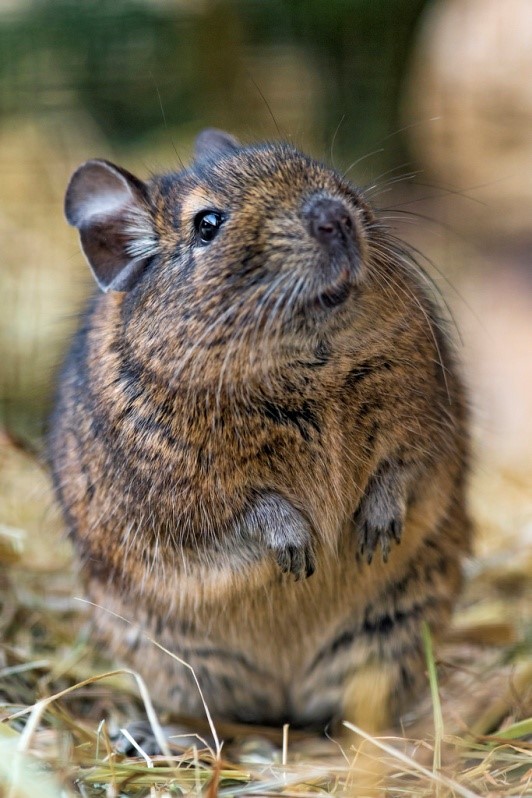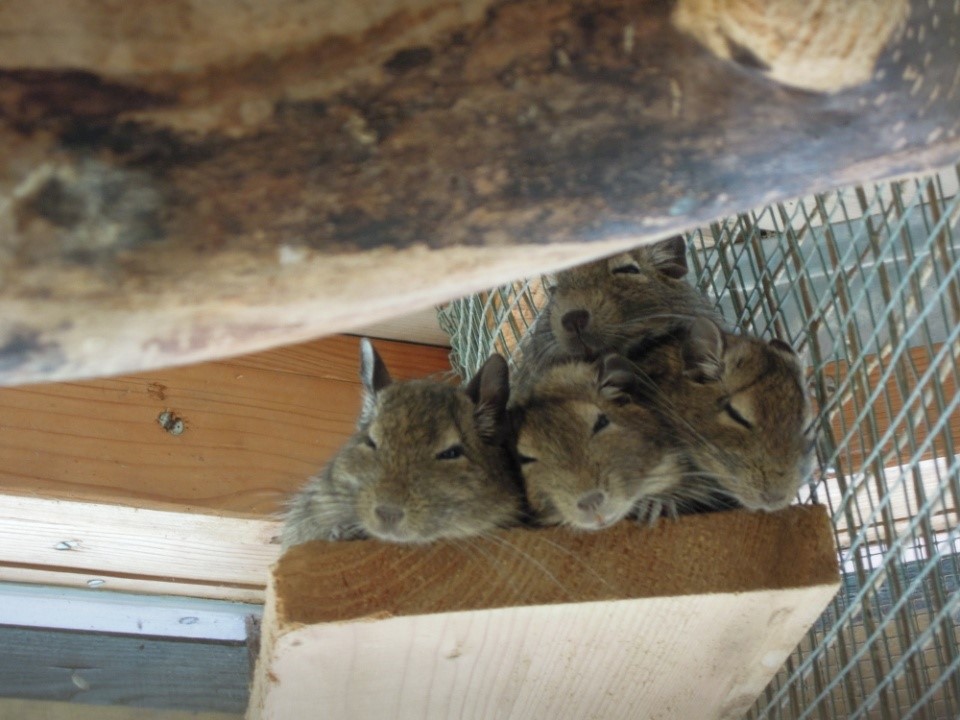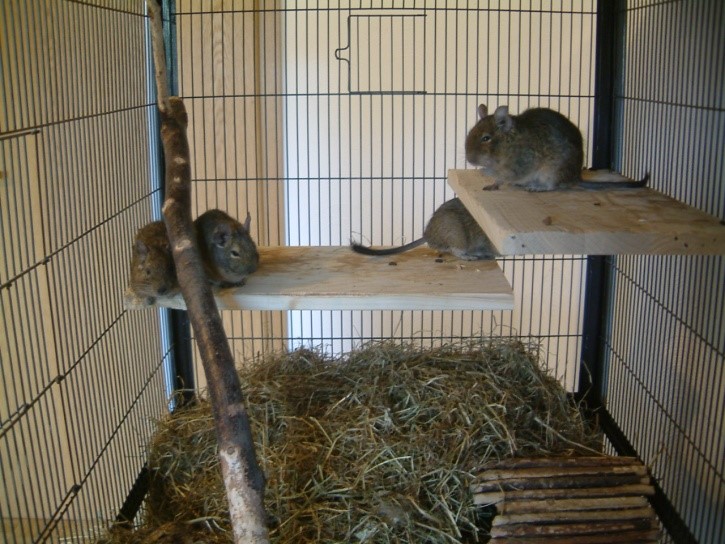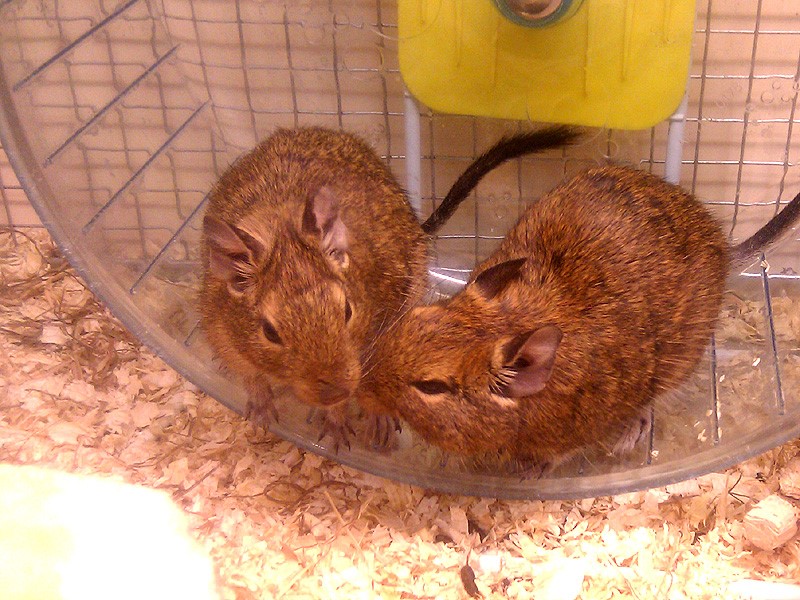How to Care for a Pet Degu

Tambako the Jaguar (CC BY-ND 2.0) Via Flickr
The common degu is a caviomorph in the rodent family that resembles a large gerbil, but is actually more closely related to chinchillas. The scientific name of the degu is Octodon degus and they are also called the brush-tailed rat. They are endemic to Chile. Degus are relatively large “pocket pets” that measure around 5-7 inches. Unlike other smaller rodents, their lifespan is relatively long, at about 5-8 years but up to 10 years is possible.
Caring for degus as pets
Most popular small rodents are solitary, but degus are very social animals and housing them with one other degu or more is the preferred way to keep them. Social interaction from the owner is even more important with degus that are kept alone; otherwise they can exhibit symptoms of boredom and stress and even become aggressive. With consistent handling, they can be very tame and intelligent pets. One big plus for degus as pets is their diurnal nature, as most small pets are nocturnal. Due to this, degus can make good pets for younger children as long as they are responsible and mature.

“Osmáci degu” by dancing_triss is licensed under CC BY 2.0
Degus in the wild
Degus are avid diggers and live in communities like meerkats and prairie dogs, creating elaborate tunnel systems that they reside in together. Degus also spend a lot of time on the surface forging for dried grasses, leaves, and seeds. Degus breed seasonally, which is autumn in Chile and the pups are born in the spring. The young are born with fur, open eyes, and good hearing. They receive protection from their parents until they are old enough to live on their own.
The degu enclosure

Tim Bartel(CC BY-SA 2.0) Via Flickr
The ideal cage for a degu is a multi-level, wire cage typical of those used for ferrets and chinchillas. As is the case for most pets, bigger is better, and since degus prefer to be housed with other degus, the cage will need to accommodate them as well. Cages made of strong wire are preferred due to the chewing habits of these animals. Beware of cages that have plastic ledges because these can be chewed as well.
Cages that use wire grates can also be problematic due to the potential for it to cause the common health problem bumble foot, which is a bacterial infection of the feet. Instead, the cage should have solid flooring and ledges. Provide a wooden nest box for your degu to sleep and hide in. This can be filled with shredded paper and other suitable substrate. The degu can also use this for chewing, so it might need to be replaced every now and then.
For the bedding material, the standard recommendations for other small animals can apply. Avoid potentially toxic bedding such as non-kiln dried pine and cedar. Also avoid wood pellets, cat litter, and sawdust. Beddings that are paper-based, such as the Care Fresh brand, straw, and non-toxic wood based shreds can all be used. You can experiment to see what your pet likes and what has the best odor control.

“Degu EOL” by Peter is licensed under CC BY 2.0
Like other smaller rodents, provide a large exercise wheel. The wheel should be large enough so that the animal’s back doesn’t form a ‘curve’ while running. This should be about 12 inches tall. Degus are aggressive chewers, so you might want to use ceramic bowls as feeding dishes and a glass water bottle. Pet stores offer many different chewing mediums, but you can also use branches from an area that is not sprayed with pesticides for cheaper enrichment. Provide diverse items for chewing from hard wood, to softer wood, to loofah and wicker balls to keep things interesting.
These chinchilla relatives also like to bathe in dust for the health of their skin and coat. Chinchilla bath dust can be purchased and poured into a shallow dish a few times a week to give your degu this option.
Temperature issues with Degus
Degus can be sensitive to high temperatures and are even prone to heat stroke because they cannot regulate their body temperature with sweating. In order to keep your pet at the recommended room temperature range, keep the degu’s cage out of direct sunlight and monitor the temperature with a thermometer. The temperature should never exceed 25 degrees C (77 degrees F) or be at the higher end of the minimum range for extended periods.
Feeding your degu
Degus require a high-fiber diet similar to that of chinchillas and guinea pigs, so high quality commercial pellets for these species can be used for the base of their diet or a recommended degu-specific diet, if you can find one. Whatever diet you choose, it should be hay-based and very low in sugar. This means no additives like molasses, which is commonly found in some of the better guinea pig foods. The diet should also have a calcium: phosphorus ratio of 2:1.
In addition to pellets, loose hay should be available at all times. Timothy hay is a popular choice, but there is also oat hay, meadow hay, orchard grass, and others. Alfalfa hay should only be used for younger animals and sparingly for adults. Make sure you degu gets plenty of hay and limit pellets, as they may choose to over-consume the pellets if you provide too much.
Fresh vegetables offer more variety and nutrition. Some options you can use include dandelion greens, green beans, parsley, carrots and sweet potato. Feed little or no cruciferous vegetables which include broccoli, kale, brussel sprouts and cabbage. Degus should have a diet low in sugar because they are prone to diabetes, so fruits should not be offered (especially dried fruit, which has even higher sugar levels). Some treat options you can use are seeds, peanuts, and nuts in shell, which will also provide enrichment.
Degu Legality
Unfortunately, these harmless animals are not legal in 6 states: Hawaii, California, Georgia, Pennsylvania, Utah, and Alaska. This is due to their so-called potential to become an invasive species. For this reason they are also completely banned in New Zealand.







